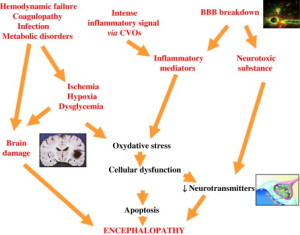Delirium is one of the symptoms of sepsis. The brain has an important role in sepsis. One of the ways is as a target for the pathologic processes involved in sepsis. Sepsis causes brain dysfunction, or sepsis-associated  (SAE). Delirium is a major component of SAE. It is associated with a change in cognition or perceptual disturbance. Important here is that Mental Dysfunction may precede the hallmark findings of sepsis, such as febrile state, high heart rate, high respiratory rate and high white blood cell count. (Zampieri, Park, Machado, & Pontes, 2011)
(SAE). Delirium is a major component of SAE. It is associated with a change in cognition or perceptual disturbance. Important here is that Mental Dysfunction may precede the hallmark findings of sepsis, such as febrile state, high heart rate, high respiratory rate and high white blood cell count. (Zampieri, Park, Machado, & Pontes, 2011)
Sepsis-associated encephalopathy (SAE) is a diffuse brain dysfunction that occurs secondary to infection in the body without overt CNS infection. Sepsis-associated encephalopathy (SAE) is a diffuse brain dysfunction that occurs secondary to infection in the body without overt CNS infection. Substantial neurological and psychological morbidities often occur in survivors. Mortality is almost always due to multiorgan failure rather than neurological complications, and is almost 70% in patients with severe SAE. (Gofton & Young, 2012) The various clinical manifestations that can present in the acute setting include inattention, disorientation, and agitation. SAE can also lead to stupor and coma. This is the most common encephalopathy in the ICU. There is increasing evidence that SAE may pose substantial risks for long-term cognitive impairments, including alterations in mental processing-speed, executive function, memory, attention, and visual-spatial abilities. These may last for several years after an admitting diagnosis of SAE, affecting functional abilities, quality of life, and the ability to return to work. Recent studies have concluded that 70% of sepsis survivors had neurocognitive impairments at hospital discharge, and up to 45% had neurocognitive impairments at 1 year. (Cory D. Lamar, Hurley, MD, Hayman, MD, & Taber, PhD, 2011)
Many patients who have been diagnosed with SAE have chronic neurocognitive sequelae up to 6 years after discharge from an ICU. Impairment was generally diffuse, but occurred primarily in areas of psychomotor speed, visual and working memory, verbal fluency, and visual construction. (Cory D. Lamar, Hurley, MD, Hayman, MD, & Taber, PhD, 2011)
Delirium is an independent risk factor for long-term cognitive impairment in patients without sepsis, and it is a term that is also used to describe patients with SAE. It is characterized as an acute impairment of cognition, with a fluctuating course, impaired attention, and altered level of consciousness. Delirium is associated with several adverse outcomes, including increased morbidity and mortality, prolonged hospitalization, and poor surgical outcome. (Cory D. Lamar, Hurley, MD, Hayman, MD, & Taber, PhD, 2011)
In SAE Mental Dysfunction may precede the hallmark findings of sepsis, such as febrile state, high heart rate, high respiratory rate and high white blood cell count. (Zampieri, Park, Machado, & Pontes, 2011) A recent case that I reviewed the patient was diagnosed and treated as if they were psychotic. 9 days later she was found to have peritonitis and was septic. Her abdomen had several liters of peritoneal fluid inside. The fact that her initial mental status was mistaken for a psychotic state probably led healthcare personnel to ignore the symptoms of sepsis that she did exhibit.
Works Cited
Cory D. Lamar, M., Hurley, MD, R. A., Hayman, MD, L. A., & Taber, PhD, K. H. (2011, June 1). Sepsis-Associated Encephalopathy: Review of the Neuropsychiatric Manifestations and Cognitive Outcome. Retrieved July 22, 2013, from The Journal of Neuropsychiatry: http://neuro.psychiatryonline.org/article.aspx?articleID=179999
Gofton, T. E., & Young, G. B. (2012, September 18). Sepsis-Associated Encephalopathy. Retrieved July 22, 2013, from Pub Med: http://www.ncbi.nlm.nih.gov/pubmed/22986430
Zampieri, F. G., Park, M., Machado, F. S., & Pontes, L. C. (2011, October). Clinics: Sepsis-Associated Encephalopathy: Not Just Delirium. Retrieved July 4, 2013, from US National Library of Medicine National Institute of Health: http://www.ncbi.nlm.nih.gov/pmc/articles/PMC3180153/
Leave a Comment